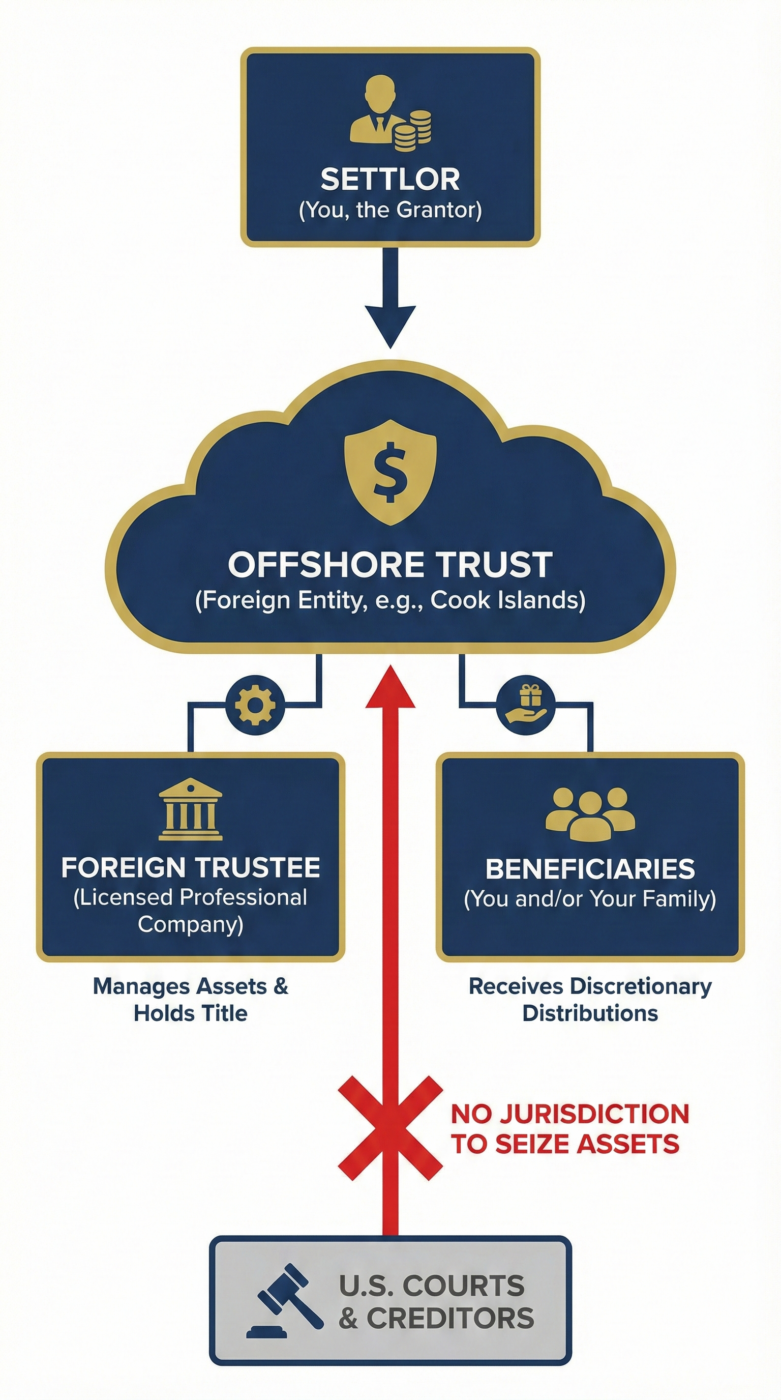Offshore Asset Protection: Comprehensive Pros & Cons Guide
In the United States, wealth is often a target. We live in the most litigious society in the world, where a single lawsuit can jeopardize decades of hard work. For high-net-worth individuals, business owners, and medical professionals, relying solely on domestic insurance or standard corporate structures is often insufficient.
This brings many of our clients to the topic of offshore asset protection.
While popular media often portrays offshore planning as a shadowy tactic for the ultra-wealthy to hide money, the legal reality is quite different. Offshore asset protection is a legitimate, statutory legal strategy designed to place a barrier between your assets and future creditors.
However, moving assets overseas is a significant decision. It involves complex legal structures, strict tax compliance, and meaningful costs. To help you make an informed decision, we have compiled this comprehensive guide on the mechanics, the benefits, and the distinct disadvantages of going offshore.
What Is Offshore Asset Protection?
At its most basic level, offshore asset protection is the process of moving assets into a legal entity—such as a trust or a limited liability company (LLC)—located in a foreign jurisdiction.
The strategy relies on a simple legal principle: jurisdiction.
When you hold assets in the U.S., they are subject to U.S. court orders. If a judge rules against you, they can order the seizure of your bank accounts or real estate. By contrast, foreign jurisdictions like the Cook Islands or Nevis are sovereign nations. They do not automatically recognize judgments from U.S. courts.
If a creditor wants to reach assets held in an offshore trust, they cannot simply present a U.S. court order. They must hire local counsel in that foreign country, file a new lawsuit, and prove their case under that country’s laws—which are written specifically to protect the defendant (you).

The Pros of Offshore Asset Protection
The primary reason to engage in offshore planning is certainty. When properly structured, these vehicles provide a level of security that domestic options simply cannot match.
- Total Insulation from U.S. Judgments. The “Full Faith and Credit” clause of the U.S. Constitution requires states to respect each other’s court orders. An offshore jurisdiction has no such obligation. If a U.S. judge orders an offshore trustee to release funds, the trustee is legally required to refuse that order. This creates a “firewall” around your wealth.
- Settlement Leverage. Litigation is a business decision. When a plaintiff’s attorney realizes that your assets are held in a jurisdiction that does not recognize U.S. judgments, the economics of the lawsuit change drastically. Facing the prospect of spending years and hundreds of thousands of dollars to litigate overseas, most creditors will choose to settle for a fraction of the original claim or drop the suit entirely.
- Short Statutes of Limitations. In the U.S., the window for a creditor to claim a “fraudulent transfer” can remain open for four years or more. Offshore jurisdictions aggressively shorten this window. In the Cook Islands, for example, a creditor generally has only one to two years from the date of the transfer to bring a claim. Once that deadline passes, the assets are virtually unassailable.
- Enhanced PrivacyWhile you must always disclose your assets to the IRS, offshore jurisdictions offer significant privacy from the general public. Unlike many U.S. states where LLC members are listed in searchable public databases, jurisdictions like Nevis do not publish the names of trust beneficiaries or LLC managers. This keeps your financial profile lower and makes you a less attractive target for frivolous lawsuits.
Get clear, actionable advice on how to protect your assets.
Alper Law has helped clients with asset protection planning for for over 30 years. We develop creative, customized strategies to protect our clients from judgments and creditors.
Attorneys Jon Alper and Gideon Alper are nationally recognized as leading experts in offshore trust formation. We provide all services remotely.
The Cons of Offshore Asset Protection
Offshore asset protection is the “nuclear option” of wealth preservation. It is powerful, but it comes with trade-offs.
- Higher Costs. This is not a low-cost strategy. Establishing an Offshore Asset Protection Trust typically costs between $15,000 and $30,000, depending on complexity. Furthermore, you must budget for annual maintenance fees (trustee fees, government registration, and compliance), which can range from $4,000 to $8,000 per year. For assets under $500,000, these costs often outweigh the benefits.
- Strict IRS Compliance & Reporting. The most persistent myth about offshore trusts is that they are tax-free or secret from the government. They are not. As a U.S. person, you are taxed on your worldwide income. You must file specific annual forms, such as Form 3520 (for foreign trusts) and the FBAR (Foreign Bank Account Report). Failure to file these forms carries severe civil penalties. You must be willing to work with a CPA who understands international reporting.
- Loss of Direct Control. To obtain the legal protection of an offshore trust, you cannot be your own trustee. You must appoint a professional foreign trustee (usually a licensed trust company). While you can act as an investment advisor and manage the assets during normal times, the trustee takes control if you are sued. This “loss of control” is actually the feature that protects you (see The Duress Clause below), but it can be psychologically difficult for some entrepreneurs.
- Complexity of Access. Accessing your funds is not as simple as swiping a debit card at the grocery store. While you can receive distributions via wire transfer effectively anywhere in the world, the extra layer of administration means you cannot treat an offshore account like a personal checking account.
How the “Duress Clause” Protects You
One of the most critical concepts to understand is the “Duress Clause.” This is standard in all our offshore trust deeds.
If a U.S. judge orders you to repatriate your assets (bring them back to the U.S.) to pay a creditor, you might be held in contempt of court if you refuse. However, with a Duress Clause, you can truthfully tell the judge: “I have requested the money, but the trustee refused.”
When the foreign trustee sees that you are acting under “duress” (a court order), they are legally bound to freeze the assets and refuse your request to send money back to the U.S. Because the foreign trustee is not under the U.S. judge’s authority, they cannot be forced to comply. This protects you from contempt of court while keeping the assets safe.
Comparison: Domestic vs. Offshore
Is it worth going offshore, or should you stay domestic? Here is how the two compare.
| Domestic Trust (DAPT) | Offshore Trust (OAPT) | |
| Jurisdiction | Nevada, Delaware, South Dakota | Cook Islands, Nevis, Belize |
| Protection Strength | Moderate (Vulnerable to U.S. Constitution) | Maximum (Sovereign Protection) |
| Setup Cost | Lower ($4k – $10k) | Higher ($15k – $30k+) |
| Control | Trustee can be family/friend (risky) | Must be Professional Foreign Trustee |
| Creditor Barrier | Must sue in another U.S. State | Must sue in a Foreign Country |
Who Should Consider an Offshore Trust?
We generally recommend offshore planning for clients who fit a specific profile. If you have liquid assets in excess of $750,000, the cost-benefit analysis usually weighs heavily in favor of offshore protection.
Common candidates include:
- Physicians and Surgeons facing malpractice liability in excess of insurance caps.
- Real Estate Developers exposed to construction defect litigation or environmental claims.
- Corporate Directors facing personal liability for business decisions.
- Family Offices seeking long-term generational wealth preservation.
If you have smaller assets or lower risk, a domestic structure or a standalone Offshore LLC may be a more cost-effective solution.
Conclusion
Offshore asset protection is the strongest legal shield available for your wealth, but it requires a commitment to transparency and proper administration. It is not about hiding money; it is about ensuring that your wealth is governed by laws that prioritize your rights over the aggressive tactics of predatory creditors.
Sign up for the latest information.
Get regular updates from our blog, where we discuss asset protection techniques and answer common questions.








